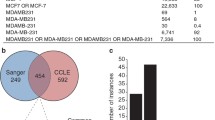Abstract
Cell line cross-contamination is a phenomenon that arises as a result of the continuous cell line culture. It has been estimated that around 20% of the cell lines are misidentified, therefore it is necessary to carry out quality control tests for the detection of this issue. Since cell line cross-contamination discovery, different methods have been applied, such as isoenzyme analysis for inter-species cross-contamination; HLA typing, and DNA fingerprinting using short tandem repeat and a variable number of tandem repeat for intra-species cross-contamination. The cell banks in this sense represent the organizations responsible for guaranteeing the authenticity of cell lines for future research and clinical uses.
Similar content being viewed by others
Abbreviations
- AFLP:
-
Amplified fragment length polymorphism
- MCB:
-
Master cell bank
- STR:
-
Short tandem repeat
- SBT:
-
Sequence based typing
- SSO:
-
Sequence specific oligonucleotide
- SSOP:
-
Sequence specific oligonucleotide probe
- VNTR:
-
Variable number tandem repeat
- WCB:
-
Working cell bank
References
AATB American Association of Tissue Banks (2002) Standards for tissue banking, 10th edn. American Association of Tissue Banks, McLean, VA
ATCC Connection Newsletter (2000) Verify cell line identity with DNA profiling 21:1
Borge OJ, Evers K (2003) Aspects on properties, use and ethical considerations of embryonic stem cells—a short review. Cytotechnology 41:59–68
Buehring GC, Eby EA, Eby MJ (2004) Cell line cross-contamination: how aware are mammalian cell culturists of the problem and how to monitor it? In Vitro Cell Dev Biol Anim 40:211–215
Cao K, Chopek M, Fernández-Vina MA (1999) High and intermediate resolution DNA typing systems for class I HLA-A, B, C genes by hybridization with SSOP. Rev Immunogenet 1:177–208
Cobo F, Stacey GN, Hunt C, Cabrera C, Nieto A, Montes R, Cortes JL, Catalina P, Barnie A, Concha A (2005) Microbiological control in stem cell banks: approaches to standardisation. Appl Microbiol Biotechnol 68:456–466
Defendi V, Billingham RE, Silvers WK, Moorhead P (1960) Immunological and karyological criteria for identification of cell lines. J Natl Cancer Inst 25:359–385
Freshney RI (1994) Culture of animal cells: a manual of basic techniques. Wiley-Liss, Inc., New York
Gartler SM (1968) Apparent HeLa cell contamination of human heteroploid cell lines. Nature 217:750–751
Gerlach JA (2001) Human lymphocyte antigen molecular typing: how to identify the 1250+ alleles out there. Arch Pathol Lab Med 126:281–284
Gey GO, Coffman WD, Kubicek MT (1952) Tissue culture studies of the proliferative capacity of cervical carcinoma and normal epithelium. Cancer Res 12:264–265
Healy L, Hunt C, Young L, Stacey GN (2005) The UK Stem Cell Bank: its role as a public research centre providing access to well-characterised seed stocks of human stem cell lines. Adv Drug Deliv Rev 57:1981–1988
Hyslop LA, Armstrong L, Stojkovic M, Lako M (2005) Human embryonic stem cells: biology and clinical implications. Expert Rev Mol Med 7:1–21
International Conference on Harmonisation of Technical requirements for registration of Pharmaceuticals for human use (1997) ICH harmonised tripartite guideline. Viral safety evaluation of biotechnology products derived from lines of human or animal origin, March
Jeffreys AJ, Wilson V, Thein SL (1985a) Hypervariable “minisatellite” regions in human DNA. Nature 314:67–73
Jeffreys AJ, Wilson V, Thein SL (1985b) Individual specific DNA fingerprints of human DNA. Nature 316:76–79
Koreth J, O’Leary JJ, O’D McGee J (1996) Microsatellites and PCR genomic analysis. J Pathol 178:239–248
MacLeod RA, Dirks WG, Matsuo Y, Kaufmann M, Milch H, Drexler HG (1999) Widespread intraspecies cross-contamination of human tumor cell lines arising at source. Int J Cancer 83:555–563
Masters JR, Thomson JA, Daly-Burns B et al (2001) Short tandem repeat profiling provide an international reference standard for human cell lines. Proc Natl Acad Sci USA 98:8012–8017
Masters JR (2002) HeLa cells 50 years on: the good, the bad and the ugly. Nat Rev Cancer 2:315–319
MCA (MHRA) (2002) Rules and guidance for pharmaceutical manufactures and distributors. The Stationery Office, London
Nelson-Rees WA, Flandermeyer RA, Hawthorne PK (1975) Distinctive banded marker chromosomes of human tumor cell lines. Int J Cancer 16:74–82
Nelson-Rees WA, Flandermeyer RA (1976) HeLa cultures defined. Science 191:96–98
Nelson-Rees WA, Daniels DW, Flandermeyer RR (1981) Cross-contamination of cells in culture. Science 212:446–452
Nims RW, Shoemaker AP, Bauernschub MA, Rec LJ, Harbell JW (1998) Sensitivity of isoenzyme analysis for the detection of interspecies cell line cross-contamination. In Vitro Cell Dev Biol Anim 34:35–39
Nomenclature for factors of the HLA system: update October 2000 (2001) Tissue Antigens 57:93–94
Page-Bright B (1982) Proving paternity-human leukocyte antigen test. J Forensic Sci 27:135–153
Rajalingam R, Ge P, Reed EF (2004) A sequencing-based typing for HLA-DQA1 alleles. Hum Immunol 65:373–379
Schaeffer WI (1990) Terminology associated with cell, tissue, and organ culture, molecular biology, and molecular genetics. Tissue Culture Association Terminology Committee. In Vitro Cell Dev Biol 26:97–101
Stacey GN, Hoelzl H, Stephenson JR, Doyle A (1997) Authentication of animal cell cultures by direct visualization of repetitive DNA, aldolase gene PCR and isoenzyme analysis. Biologicals 25:75–85
Stacey GN (2000) Cell contamination leads to inaccurate data: we must take action now. Nature 403:356
Stevanovic S (2002). Structural basis of immunogenicity. Transpl Immunol 10:133–136
Tamaki K, Jeffreys AJ (2005) Human tandem repeat sequences in forensic DNA typing. Leg Med (Tokyo) 7:244–250
United Kingdom Coordinating Committee on Cancer Research (2000) Br J Cancer 82:1495–1509
Welsh K, Bunce M (1999) Molecular typing for the MHC with PCR-SSP. Rev Immunogenet 1:157–176
Wong Z, Wilson V, Patel I, Povey S, Jeffreys AJ (1987) Characterization of a panel of highly variable minisatellites cloned from human DNA. Ann Hum Genet 51:269–288
World Health Organization (1987) Acceptability of cell substrates for production of biologicals. Technical Report Series. WHO, Geneva
Acknowledgements
We thank Ms. Angela Barnie for checking the use of English in the manuscript.
Author information
Authors and Affiliations
Corresponding author
Rights and permissions
About this article
Cite this article
Cabrera, C.M., Cobo, F., Nieto, A. et al. Identity tests: determination of cell line cross-contamination. Cytotechnology 51, 45–50 (2006). https://doi.org/10.1007/s10616-006-9013-8
Received:
Accepted:
Published:
Issue Date:
DOI: https://doi.org/10.1007/s10616-006-9013-8




